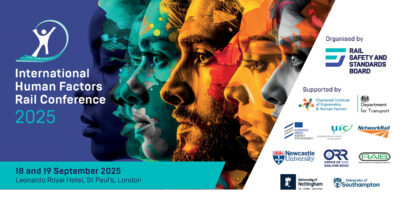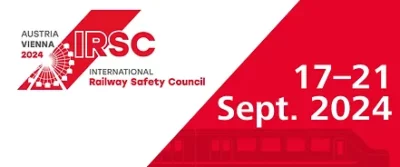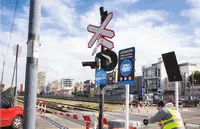Are you interested in HOF?
Do you want to learn about Human & Organisational Factors? Safety culture, non-technical skills, health and safety, more?
Join us on this international and diverse network which captures in one place the valuable and enriching information and material, either academic or practical railways-oriented, on the organizational and human factors that you need.
Are you involved in HOF activities?
Join our international network for valuable academic and Railways-oriented resources.
Are you an HOF expert?
To access confidential information and a discussion forum for peer exchanges.
What is HOF?
Human and Organisational Factors (HOF) study interactions between humans and system elements, using theories and methods to optimize human well-being and system performance (International Ergonomics Association).
HOF, also known as Human Factors or Ergonomics outside the rail sector, integrates knowledge from various sciences such as Management, Sociology, Design, Politics, Economics, Psychology, Physiology, and Engineering. This broadens the study to include organisational, cultural, and political factors affecting safety (ERA).
HOF supports safety integration in design and identifies gaps between prescribed tasks and actual work, addressing residual risks. This approach enhances management in complex organisations like railway systems, crucial for safety improvements (European Railway Agency).
What are HOFs in concrete terms?
Human Factors is one of those terms that everybody has heard of, but the full scope of what human factors covers isn’t always obvious. Human Factors (the American term), ergonomics (the UK term), or Human and Organisational Factors (ERA term), is about designing work in a way that matches the abilities, needs and limitations of the people doing the work. It is a very broad discipline, rooted in an understanding of the psychology and physiology of humans, but applying that knowledge to the design of equipment, tools, information, processes, and procedures. Read more
Why do people make errors?
What are non-technical skills?
What are error prevention techniques?
Why do people break rules?
What are performance influencing factors?
 Our Solutions
Our Solutions
Enhancing safety management
The safety management system (SMS) is part of the business processes of the organisation and is not just a paper-based system specifically developed for demonstrating compliance with the regulatory framework. …
Categories
- Safety culture
- Safety leadership
- Return on operating experience
- HOF in change management
- HOF in event investigation
- HOF in Design
- HOF in risk management
- Just and Fair Culture
- Competence management system
Human Performance
The term Human Performance refers to the contribution that humans make to the performance of a system. It describes how people carry out their work, whether as an individual or as a team, in order to meet a required objective. ….
Categories
- Non-technical skills
- Fatigue management
- Human error (and violations)
- Workload
- Vigilance and distraction
- Fitness for duty
- Physical ergonomics
- Stress
- Situation awareness
- Attention
HOF regulations, standards and tools
The systematic integration of HOF cannot be done without having a consistent reference base in the form of regulations, standards and tools. This basis makes it possible to develop the integration of HOF in the Safety Management System (SMS). …
Categories
HOF in practice
The human factors discipline provides a theoretical knowledge base which can be applied to optimise systems for safety, human performance and wellbeing. These theory, principles, and methods can be applied in at different stages of the lifecycle …
Categories
 Share Your Experiences
Share Your Experiences
The SNCF’s Just & Fair approach
What are the key HOF issues?
In 2015, SNCF launched a major safety program (called PRISME) to improve its overall safety performance. As baseline of this program, the company has deployed a Just & Fair (J&F) approach to create a climate of trust and then encourage everyone to report safety problems and thus being able to fix them.
What did you do?
To support its just culture ... READ MORE
Co-construction of a Safety Culture model at SNCF
What are the key HOF issues? In 2020, SNCF became a unified public group composed by several anonymous companies. Given the status change, it was important to provide a common and unique definition of Safety Culture for the entire SNCF group. By officialising its own definition and Safety Culture model, SNCF group set in stone its ambition in terms of safety excellence. What did you do? To carry out this READ MORE
Automation Myth Busting Paper#2 The Changing Role of Staff in Automated Railway Operation and why Human Cognition is Here to Stay
Automated mainline railway operation is challenging the traditional role of the operational staff ensuring safe and punctual service. Nevertheless, there are sound operational, economic, regulatory and societal reasons for valuing and maintaining central contributions of human staff to railway operation in future automated service. Instead of a linear transferal of tasks from the human to the automation technology a human-machine ... READ MORE
Automation Myth Busting Paper#3 Automation and mental workload
Automation paradoxically has the potential to both increase and decrease mental workload, depending on the circumstances. Furthermore, decreasing workload can actually put an operator into an underload state, which is just as bad for performance as overload. We have learned these lessons in the aviation and, more recently, automotive industries; as accident reports demonstrate, we are now starting to see their impact on the railway with the ... READ MORE
Automation Myth Busting Paper#4 Teaming between humans and automation
Due to technological advances, automation is nowadays no longer regarded only as a tool for humans but, due to the execution of complex tasks, is increasingly discussed in terms of a team member. This article describes how successful teaming can optimally be realized so that the strengths of the human operator and the automation are brought to bear. The decisive factor is a human-centred work design that focuses on the needs of human ... READ MORE
Latest News and Updates
International Human Factors Rail Conference 2025 (RSSB)
The 8th International Human Factors Rail Conference which will be held in London at the Leonardo Royal Hotel, on 18 and 19 September 2025. The conference is organised by Rail Safety and Standards Board (RSSB) and in addition to UIC supported by; Chartered Institute of...
InnoTrans 2024 · 24-27 SEP 2024 in Berlin – The future of mobility
International Railway Safety Council 2024 (17 – 21 September 2024) hosted by ÖBB
HOF in Risk Management Conference 2024 | European Union Agency for Railways (europa.eu)






